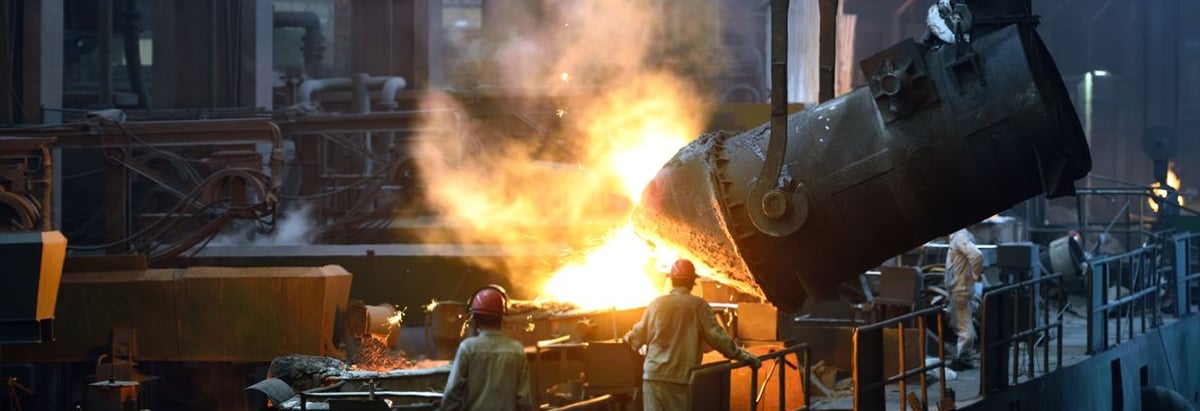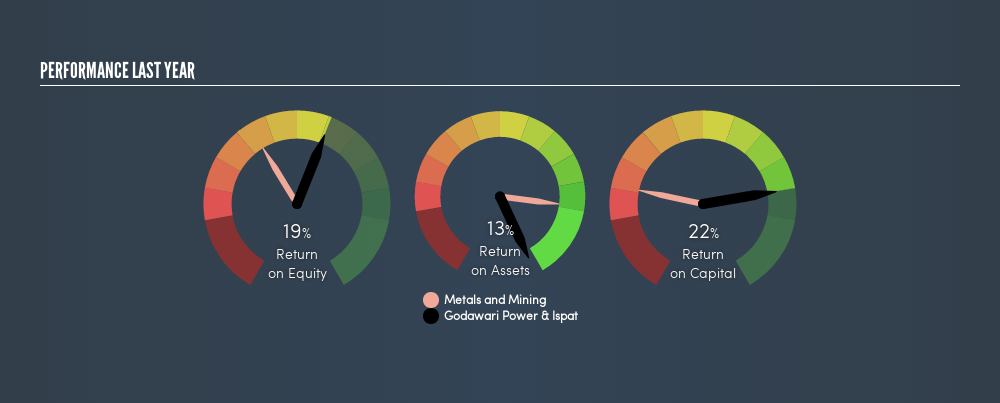- India
- /
- Metals and Mining
- /
- NSEI:GPIL
Godawari Power & Ispat Limited (NSE:GPIL) Earns A Nice Return On Capital Employed

Today we'll look at Godawari Power & Ispat Limited (NSE:GPIL) and reflect on its potential as an investment. To be precise, we'll consider its Return On Capital Employed (ROCE), as that will inform our view of the quality of the business.
First up, we'll look at what ROCE is and how we calculate it. Next, we'll compare it to others in its industry. And finally, we'll look at how its current liabilities are impacting its ROCE.
Return On Capital Employed (ROCE): What is it?
ROCE is a metric for evaluating how much pre-tax income (in percentage terms) a company earns on the capital invested in its business. In general, businesses with a higher ROCE are usually better quality. In brief, it is a useful tool, but it is not without drawbacks. Renowned investment researcher Michael Mauboussin has suggested that a high ROCE can indicate that 'one dollar invested in the company generates value of more than one dollar'.
So, How Do We Calculate ROCE?
The formula for calculating the return on capital employed is:
Return on Capital Employed = Earnings Before Interest and Tax (EBIT) ÷ (Total Assets - Current Liabilities)
Or for Godawari Power & Ispat:
0.22 = ₹6.5b ÷ (₹35b - ₹5.2b) (Based on the trailing twelve months to June 2019.)
Therefore, Godawari Power & Ispat has an ROCE of 22%.
See our latest analysis for Godawari Power & Ispat
Is Godawari Power & Ispat's ROCE Good?
One way to assess ROCE is to compare similar companies. In our analysis, Godawari Power & Ispat's ROCE is meaningfully higher than the 14% average in the Metals and Mining industry. I think that's good to see, since it implies the company is better than other companies at making the most of its capital. Independently of how Godawari Power & Ispat compares to its industry, its ROCE in absolute terms appears decent, and the company may be worthy of closer investigation.
Our data shows that Godawari Power & Ispat currently has an ROCE of 22%, compared to its ROCE of 2.7% 3 years ago. This makes us think about whether the company has been reinvesting shrewdly.

Remember that this metric is backwards looking - it shows what has happened in the past, and does not accurately predict the future. ROCE can be misleading for companies in cyclical industries, with returns looking impressive during the boom times, but very weak during the busts. ROCE is only a point-in-time measure. Remember that most companies like Godawari Power & Ispat are cyclical businesses. Future performance is what matters, and you can see analyst predictions in our free report on analyst forecasts for the company.
Do Godawari Power & Ispat's Current Liabilities Skew Its ROCE?
Liabilities, such as supplier bills and bank overdrafts, are referred to as current liabilities if they need to be paid within 12 months. The ROCE equation subtracts current liabilities from capital employed, so a company with a lot of current liabilities appears to have less capital employed, and a higher ROCE than otherwise. To check the impact of this, we calculate if a company has high current liabilities relative to its total assets.
Godawari Power & Ispat has total liabilities of ₹5.2b and total assets of ₹35b. As a result, its current liabilities are equal to approximately 15% of its total assets. Current liabilities are minimal, limiting the impact on ROCE.
What We Can Learn From Godawari Power & Ispat's ROCE
With that in mind, Godawari Power & Ispat's ROCE appears pretty good. There might be better investments than Godawari Power & Ispat out there, but you will have to work hard to find them . These promising businesses with rapidly growing earnings might be right up your alley.
I will like Godawari Power & Ispat better if I see some big insider buys. While we wait, check out this free list of growing companies with considerable, recent, insider buying.
We aim to bring you long-term focused research analysis driven by fundamental data. Note that our analysis may not factor in the latest price-sensitive company announcements or qualitative material.
If you spot an error that warrants correction, please contact the editor at editorial-team@simplywallst.com. This article by Simply Wall St is general in nature. It does not constitute a recommendation to buy or sell any stock, and does not take account of your objectives, or your financial situation. Simply Wall St has no position in the stocks mentioned. Thank you for reading.
About NSEI:GPIL
Flawless balance sheet with reasonable growth potential and pays a dividend.
Similar Companies
Market Insights
Community Narratives



